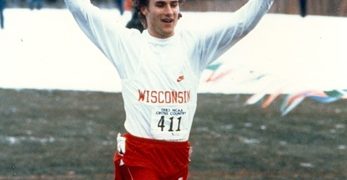This piece is on the huge success that World Athletics has had this past two years and where it could go in the future. Deji suggest some fascinating opportunities for growth in World Athletics and what they really need to do!
RelatedPosts
Early track spikes, cobbled by Adi Dassler, photo by adidas Communications
What does a proposed Netflix series mean for Athletics?
In the middle of December 2021, figures from the Tokyo Olympics showed that track and field is more popular than any other sport after it garnered the highest number of broadcast viewing hours -2.2 million hours, at the Games.
A few days after these figures were released, World Athletics president Seb Coe, talked about how important it was to translate these figures into genuine content that will resonant amongst the younger generation of viewers who form the large chunk of audiences in most sports, thereby keeping athletics at the top.
“Athletics had the largest number of media articles written about it – some 10,000 – compared to other sports,” he said. “We had the highest number of shared articles across social media, which was roughly about 700 million, and that led to over 62 million conversations on social media around athletics, plus the highest number of video views across the IOC and the Tokyo Olympic Games websites and app of more than half a million.”
Although the Olympics is the greatest show on earth, let’s face it, it comes up once every four years and for about a month. Any serious global sporting body cannot rely solely on these numbers to determine the reach of its sport.
As the sporting world evolves, it’s absolutely pertinent Athletics isn’t left behind. Streaming services such as Netflix, Amazon, and Apple TV have revolutionized how we take in content. Most importantly, sports have not been left behind on the train. In order to reach a much younger generation of audience who consume most of these contents, some sports have rejigged how they dish out the live content.
Football, Formula 1, Basketball have all bought into this idea of making some or a large chunk of their sport into reality TV. A feature that has seen an exponential increase in its audiences and translates to more money for their governing body.
Drive to Survive, an F1 docuseries, provides a behind-the-scenes look at the circuit that uses the world as its playground, highlighting the action and providing context to storylines that emerge both on and off the course. It has attracted more sponsors and boosted the popularity of the sports in other regions of the world.
The same goes for The Last Dance docuseries on Michael Jordan, while European Football teams have had documentaries on their teams in order to give more insides about their favorite sports.
Interestingly, Coe says World Athletics plans to work on improving the sport’s popularity in 2022 and have a brilliant opportunity to leave “an indelible footprint” at the World Championships in Eugene, Oregon.
The global governing body plans to do this via social media but without neglecting the role of television. “We can’t underestimate the power of TV,” says Coe.
Formula 1 used to be seen as a sport for the Old boys club. As recent as four years ago, it was suffering from decreasing interest and loss in sponsorship deals, a theme that is similar to the current state of athletics. Over the past few decades, revenue was generated through TV rights and race hosting fees. These themes are not too far away from what’s facing athletics.
Over the years, track and field has tried to develop new ways for the sport to be enticing, but most times, the changes have usually left fans reeling about how World Athletics comes up with such ideas or them completing rebutting them.
From still not getting it right with the Diamond League timing, not airing some important continental Gold Tour meets, changing the scoring system for the vertical and horizontal jumps and more recently introducing cameras to the starting blocks, it’s all had a long-term positive change on the sport.
Having additional athletics content out there that reaches a wide and different audience helps increase awareness and interest, and hopefully incentivizes the audience to tune into the meets.
Evolving into the digital landscape is absolutely crucial and reality TV will help broaden the scope. These TV streaming giants particularize in creating storylines that will be compelling. They will be tasked with creating something that will provide a different variant from the live coverage that exists of the sport.
There’s a whole part of the sport that’s happing behind the scenes- in the warm-up areas, the hospitalities, the gaps between the races, and the constraints of athletes flying all over the world to meets. People watch these athletes on race day, but beyond that, nobody really knows who they are.
Usain Bolt seems to have been one athlete that attracted such stories, but more still needs to be done around many other athletes. Telling their stories and capturing them in a way that’s harder to show in live race coverage.
Who wouldn’t want to watch a series that involves how the likes of Sha’Carri Richardson and Elaine Thompson build up themselves until a major championship or how Shelly-Ann Fraser-Pryce and Faith Kipyegon combine motherhood with training for a grueling sport like track and field? There are lots of compelling stories to pick from.
What all of these do is to introduce people to the human side of athletics, instead of overwhelming them with a tidal wave of numbers and hoping they’ll eventually follow along.
To add to these, an unprecedented marketing campaign is needed for the sport; Official Esport competitions, betting deals, and collecting more data to show the level of support for the sport outside major championships like the Olympics and World Championships.
Exploiting the marketing potential of the internet is also pivotal. Getting through to millennials and Gen Z’s that are connected through these channels. These fans have the potential to support the sport for many decades to come.
Producing videos and images that can be turned into engaging social media posts alongside the basic highlights that come through every race at major competitions will also add to the appeal of the sport.
Doubling down and providing value for track and field’s most passionate fans who want to go deeper with their experience of the sport can serve up a good appeal. Getting an app that can offer real-time statistics and in-depth analysis instead of having to go to the World Athletics website ultimately does the trick. I want to be able to see the 2021 times of Noah Lyles with just the click of a button on my mobile device.
It’s all a hodgepodge of ideas but the docuseries is at the top of the pack, something that can eventually change the way we view athletics and make it resonate in the minds of all and sundry. World Athletics makes more money, the sport’s popularity gets to explode and the audience gets to binge-watch different types of content in track and field It’s a win-win for all parties.
Author
Mark Winitz, long time scribe for California Track & Running News and American Track & Field, is a contributing writer on RunBlogRun.com.
View all posts




















